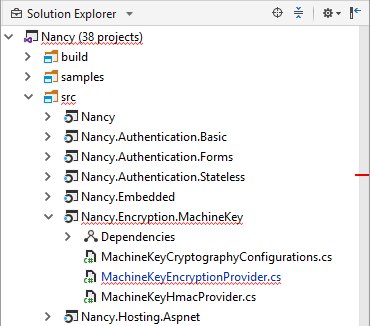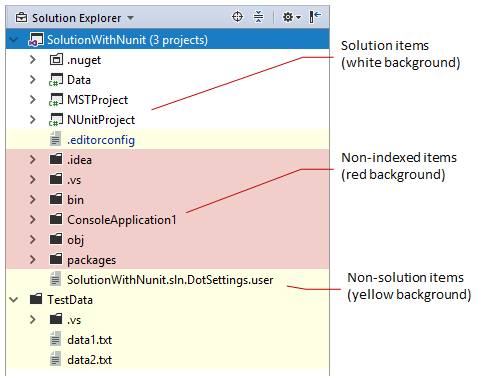Solution window
Ctrl+Alt+L
The Solution tool window lets you look at your solution from various viewpoints and perform the tasks such as creating new items (directories, files, classes, etc.), opening files in the editor, navigating to the code fragment of interest, and more.
Most of the functions in this tool window are accessed as context menu commands in the content pane and associated shortcuts.
Views
The tool window provides you with the following views:
- Unity Explorer view. Provides an organized view of all assets in a Unity project (you see exactly the same project tree as in the Unity editor). Available only for Unity projects.
- Solution Explorer view. Provides an organized view of projects and project items in the current solution.
- Scratches view. This view lets you manage your scratch files and database consoles.
The necessary view is selected from the list in the left-hand part of the title bar or, if the views are represented by tabs, by clicking the corresponding tab.
To configure a view, use the corresponding options in the title bar context menu. The necessary options can also be accessed by clicking ![]() on the title bar.
on the title bar.
Code analysis in Solution Explorer
When solution-wide analysis is enabled, files where JetBrains Rider has detected errors as well as all their parent items are highlighted with red underlines in the Solution Explorer:

Title bar context menu
The context menu that appears by right-clicking on the title bar, provides settings for solution views, viewing modes, as well as for switching between the views, resizing the tool window, and more.
The following table lists and briefly explains the available commands and options.
| Item | Shortcut | Description |
|---|---|---|
| Select Next View or Tab Select Previous View or Tab Show List of Views or Tabs | Alt+Right Alt+Left Alt+Down | These are the commands for switching between different views. |
| Autoscroll to Source | If this option is on, JetBrains Rider will automatically open the selected item in the editor. | |
| Autoscroll from Source | If this option is on, JetBrains Rider automatically locates documents that you open in the editor in the Solution tool window. | |
| Show All Files | By default, JetBrains Rider only displays projects, files and references that are included in the current solution. You can use the Show All Files option to additionally display all subdirectories and files that are located on the file system under the solution directory, as well as external items in the current solution. For your convenience, those items are shown in yellow (non-solution files that are indexed by JetBrains Rider, meaning that you can use, for example, Ctrl+Shift+F to search in those files) and red (non-indexed items):  | |
| Show All Project Items | By default, JetBrains Rider hides some project items in Solution Explorer (MSBuild-generated files, default references, etc.). You can use this option to display the full logical project structure, including hidden project items. In contrast to Show All Files, this option lets you display only items included in the projects, even if these items are not located under the solution directory. | |
| Pinned, Docked, Floating, Windowed, Split Mode | These options let you control general appearance and behavior of the tool window. See Tool Windows Viewing Modes. | |
| Remove from Sidebar | This command hides the tool window, removes the associated tool window button from the tool window bar and removes the tool window from the quick access menu ( To open the tool window again (and restore the associated features), use the main menu: . | |
| Group Tabs | If this option is on, there is a list in the left-hand part of the title bar from which you can select the necessary view. If this option is off, the views are represented by tabs which appear in the left-hand part of the title bar. | |
| Move to | To associate the tool window with a different tool window bar, select this command, and then select the destination tool window bar (Top, Left, Bottom or Right). | |
| Resize | To resize the tool window by moving one of its borders, select this command, and then select the necessary Stretch to option. Note that this command is not available for the floating mode. | |
| Hide | Shift+Escape | Use this command to hide the tool window. |
Title bar buttons
| Item | Shortcut | Description |
|---|---|---|
| | Alt+Right Alt+Left | If the views are currently shown as tabs (the Group Tabs option is off), this button appears to the right of the last visible tab. If the first or the last of the available views is currently selected, this button is shown as Click this button to open the list of views, for example, to select a different view. |
| | Click this icon to navigate from a file in the editor to the corresponding node (file, class, field, method, etc.) in the Project tool window. This icon is not available if the Autoscroll from Source option is currently on. | |
| | Ctrl+NumPad Minus | Use this icon or shortcut to collapse all the nodes. |
| | Use this button to open a menu whose options are a subset of the title bar context menu. | |
| | Shift+Escape | Use this icon or shortcut to hide the tool window. When used in combination with the Alt key, clicking this icon hides all the tool windows attached to the same tool window bar. |
Content pane
The content pane shows the solution items such as directories, files, etc.
Context menu commands for the content pane items
The context menu of an item provides access to all the functions available for this item.
| Item | Shortcut | Description |
|---|---|---|
| New | Ctrl+N | Use this command to create a new item (directory, file, or class). within the selected one (solution or directory). |
| Add Existing Item | Use this command to associate an existing file or directory with your solution. | |
| Cut | Ctrl+X | Use this command to move the selected item or items from the current location to the clipboard. |
| Copy | Ctrl+C | Use this command to copy the selected item or items to the clipboard. |
| Copy Path(s) | Ctrl+Shift+C | Use this command to copy the full path(s) of the selected item or items to the clipboard. |
| Paste | Ctrl+V | Use this command to insert the contents of the clipboard into the selected location. |
| Rename | Ctrl+R, R | Use this command to invoke the Rename refactoring for the current file or folder. |
| Edit [file] | F4 | Use this command to open the selected file in the editor. If the file is already open, the corresponding editor tab will become active. |
| Refactor This | Ctrl+Shift+R | Use this command to perform one of the refactorings available for the selected item. |
| Delete | Delete | Use this command to delete the selected item. Note that this command will remove the selected file or project from the solution and from the file system. Therefore, use this command only if you are absolutely sure that the item is not used anywhere. In all other cases, use the Safe Delete refactoring (Ctrl+R, D). |
| Change Dialect (<CurrentDialect>) | For SQL files and database consoles: change the SQL dialect associated with the file or console. | |
| Run '<item_name>' | Ctrl+F5 | For an SQL file or database console: execute all the statements contained in the selected file or console. |
| Local History | Use this command to view local history for the selected file or directory, or to create a label for the current version of your solution. SeeLocal History. | |
| Synchronize '<item_name>' | Use this command to synchronize the selected item with its version saved in the file system. (If you change a file or directory contents externally, JetBrains Rider, under certain circumstances, may not be aware of the corresponding changes unless you use this command.) | |
| Show in Explorer | Use this command to open a file browser (e.g. Windows Explorer or Finder) and show the selected item there. | |
| File Path / Directory Path | N/A | This menu shows the path from the file system root to the selected element with individual directories as the menu items. When you select an item in this menu (e.g. a directory), a file browser (e.g. Windows Explorer or Finder) opens, and the selected item is shown there. |
| Compare With | Ctrl+D | Use this command to compare the selected file or directory with another file or directory. See Comparing Files and Folders and Differences Viewer for Folders. |
File status highlights
If VCS integration is enabled for the current solution, JetBrains Rider uses colors to denote VCS file status in the Solution tool window. The following table presents information about the meaning of the colors.
| Color | File Status | Description |
|---|---|---|
| Black | Up to date | File is unchanged. |
| Gray | Deleted | File is scheduled for deletion from the repository. |
| Blue | Modified | File has changed since the last synchronization. |
| Green | Added | File is scheduled for addition to the repository. |
| Violet | Merged | File is merged by your VCS as a result of an update. |
| Brown | Unversioned | File exists locally, but is not in the repository, and is not scheduled for adding. |
| Olive | Ignored | File will be ignored in any VCS operation. |
| Light brown | Hijacked | File is modified without checkout. This status is valid for the files under Perforce, ClearCase and VSS. modified without checkout. |
| Red | Merged with conflicts | During the last update, file was merged with conflicts. |
| Lilac | Externally deleted | File is deleted locally, but was not scheduled for deletion, and still exists in the CVS repository. |
| Dark cyan | Switched | The file is taken from a different branch than the whole project. This status is valid for CVS and SVN. |